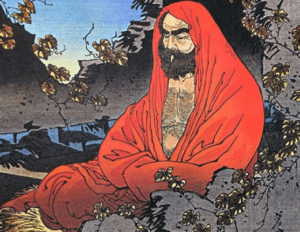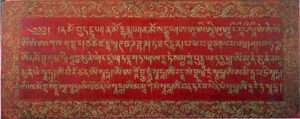
Bodhidharma, known as Dámó in China and Daruma in Japan, is credited with founding Chan Buddhism, which later became Zen Buddhism in Japan.
Mysterious Beginnings.
The accounts of Bodhidharma’s life are largely shrouded in legend, with historical sources being virtually nonexistent. One of the most frequently recounted tales about him is as follows.
Early Life and Monastic Journey.
Born in Kanchipuram, India, around 450-500 A.D., he was the third son of a prominent king but displayed a deep interest in Buddhist teachings from a young age, even demonstrating wisdom as a seven-year-old.
Under the guidance of his mentor, Prajnatara 1, he embraced a monastic life, adopting the name Bodhidharma and dedicating himself to studying the ways of the Buddha within a monastery.
The Journey to China.
After his father’s passing, Bodhidharma committed himself to spreading Buddhist knowledge and beliefs throughout India, guided by his mentor. Following his mentor’s death, he left the monastery, embarking on a journey to China to fulfill his master’s final wish: to disseminate authentic Buddhist teachings there.
The precise route of Bodhidharma’s journey to China remains a mystery. It is believed that he sailed from Madras (Chennai) to Guangzhou in China via the sea, then traveled overland to Nanjing. Some scholars speculate that he crossed the challenging Pamir Plateau on foot, following the Yellow River (Huang He) to reach Luoyang, a thriving center of Buddhism at the time. This challenging journey spanned approximately three years.
Teaching Meditation in China.

Upon his arrival in China, Bodhidharma faced significant opposition due to his emphasis on authentic meditation-based Buddhism, in contrast to the prevailing focus on Buddhist scriptures (Tripitaka/Tipitaka). He asserted that enlightenment could only be attained through the practice of Dhyana (Zazen) 2, rather than relying solely on scriptures.
His teaching style led to rejection and ostracism, forcing him to live as a beggar for several months. Later, he traveled to the Henan province, where he settled in a cave, practicing Zazen while facing a wall in complete silence for an astonishing nine years.
Impressed by his unwavering dedication, the Shaolin monks eventually admitted him access to the monastery. There, he shared his distinctive “wall-facing” meditation, reminiscent of the Soto Zen 3 tradition.
Legacy and Influence.
Bodhidharma continued to teach at the temple for many years before passing away at the age of +100. Tragically, he was poisoned by a disgruntled disciple who had not been chosen as his successor.
Bodhidharma remained a dynamic teacher who encouraged all Buddhists, whether monks or laypeople, to strive for their best in this lifetime. He rejected the concept of earning merits through donations, affirming that everyone possesses Buddha nature and encouraging all to awaken to it.
The spread of “Chan” across Asia.
When Bodhidharma brought his teaching to China it became known as “Chan”. And when it spread to Vietnam it became “Thien”. In Korea, it became known as “Son”, and when it spread to Japan it became “Zen”. The Japanese version of “Zen” is the one that came to the West first.
Thanks for reading
Gert
Footnotes.
1 Prajnatara (Prajñātārā), also known as Keyura, Prajnadhara, or Hannyatara, was the twenty-seventh patriarch of Indian Buddhism according to Chan Buddhism, and the teacher of Bodhidharma.
2 Dhyana/Zazen can be used to refer to either meditation or the stages of spiritual absorption that the mind enters during deep meditation. It follows the method of quiet sitting and meditation as a means of obtaining enlightenment.
3 In Soto Zen, meditation (zazen) is a cornerstone. But it’s not about seeking anything. It’s about being fully present, just sitting, and letting thoughts come and go like clouds in the sky.
Share this article